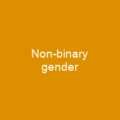Understanding Gender Identity
What is gender identity, and how does it differ from assigned sex? Gender identity refers to a person’s internal sense of their own gender, which can align with or diverge from the sex they were assigned at birth. This concept challenges the traditional binary view of gender, highlighting that one’s gender is not solely determined by biological factors but also influenced by social and environmental elements.
The Evolution of Terms
How did we arrive at the term ‘gender identity’? In 1964, psychologist Robert J. Stoller coined this term, which was later popularized by John Money. This terminology has since become integral to discussions around gender and sexuality.
The Gender Binary
Most societies adhere to a strict division between male and female attributes, known as the gender binary. This binary system often limits individuals who do not fit neatly into these categories, such as those identifying as transgender, non-binary, or genderqueer.
The Nature vs. Nurture Debate
When does our sense of gender form, and is it influenced by nature or nurture? Research suggests that core gender identity develops rapidly in early childhood but can be complex to define. Some studies indicate that by age 3, a child’s gender identity may be largely established, while others propose that it can evolve over time.
The Case of David Reimer
David Reimer’s story is often cited in discussions about the nature versus nurture debate in gender identity. Raised as a girl after undergoing sex reassignment surgery at 17 months, he later rejected his female identity and transitioned to male.
The Impact of Early Socialization
How does early socialization influence our sense of gender? The Reimer case highlights the complex interplay between biological factors and environmental influences. While some argue that core gender identity is formed by age 3, others suggest it can be changed later in life.
Biological vs. Social Influences
Factors such as nature (biological) versus nurture (social environmental) play significant roles in the formation of gender identity. Social factors like family, authority figures, and cultural influences shape a person’s sense of self, while biological factors include genetic and hormonal elements.
The Role of Genetics
How do genetics influence our understanding of gender identity? Large-scale twin studies suggest that genetic factors play a significant role in the development of both transgender and cisgender identities. Biological variables such as genes and hormones may affect how we perceive and express our gender.
Intersex Individuals
Intersex people possess variations in sex characteristics that challenge traditional binary notions of male or female bodies. Research indicates that these individuals may experience increased risk of later-initiated gender reassignment, but core gender identity might be influenced by prenatal androgens.
The Experience of Intersex Individuals
How do intersex individuals navigate their gender identities? Studies show that 78% of female-raised intersex individuals with specific conditions identified as female, while 22% decided to initiate a sex change to male. These findings suggest that genetic variables can significantly impact gender identity independent of socialization.
The Legal and Social Landscape
Currently, only 53% of the LGBTQ population lives in states prohibiting housing discrimination based on sexual orientation and gender identity. This highlights the ongoing challenges faced by individuals who do not conform to traditional gender norms.
The Yogyakarta Principles
What are the Yogyakarta Principles, and how do they impact our understanding of gender identity? These principles define gender identity as each person’s deeply felt internal and individual experience of gender. They emphasize that no one should be forced to undergo medical procedures for legal recognition of their gender identity.
The Future of Gender Identity
No objective measurement or imaging exists for gender identity, as it is part of one’s subjective experience. However, numerous clinical measurements do exist, including questionnaire-based, interview-based, and task-based assessments to help understand and support individuals with diverse gender identities.
The Diverse Spectrum
How does the concept of gender identity extend beyond the binary? Many cultures recognize more than two genders. For instance, fa’afafine in Samoa and hijras in India are recognized as distinct third genders, challenging Western notions of gender.
The Conclusion
In conclusion, understanding gender identity involves recognizing its complexity and diversity. It is a personal sense that can be influenced by both biological and social factors. As society continues to evolve, so too does our comprehension of what it means to have a gender identity that may or may not align with traditional norms.

You want to know more about Gender identity?
This page is based on the article Gender identity published in Wikipedia (retrieved on March 1, 2025) and was automatically summarized using artificial intelligence.







